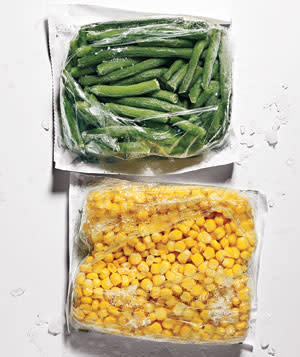Guide to Buying Frozen Food
By Elizabeth Somer, R.D.
Time-saving, yes. But frozen food can also be nutritious―if you know what to look for.
Picking Produce
Frozen vegetables and fruits can actually be more nutritious than fresh, since they're packaged immediately after harvesting and the nutrients stay at their peak. Vegetables and fruits typically last for about eight months unopened in the freezer.
Related: Busting 10 Diet Myths
Vegetables
Look for: Plain, 100 percent vegetables (they should be the only things on the ingredient list). There's no nutritional difference among the boxed, bagged, or steam-in-bag plain varieties, so go with whatever you like. Make sure the vegetables haven't frozen into a lump―a sign that they have been thawed and refrozen. This means they retain fewer vitamins, says Sarah Krieger, a registered dietitian in St. Petersburg, Florida, and a spokesperson for the American Dietetic Association.
Related: 24 Nutritious (and Tasty) Snacks
Avoid: Anything mixed with cheese, topped with sauce (such as garlic), or accompanied by pasta or rice. A cup of plain frozen broccoli, for example, has 30 calories, no fat, and 20 milligrams of sodium. Package that same vegetable in a cheese sauce and the calories more than double and the sodium soars to about 600 milligrams.
Related: Healthy Fast Food and Takeout
Tip: Speed up meal prep during the week and amp up nutritional content by adding frozen vegetables (thawed in the microwave or a bowl of cool water) to casseroles, stews, and soups. You can also blend them into dips and use them to top fresh salads.
Fruit
Look for: Again, pure and simple fruit is the best option. The bags will stay good for about two months after they've been opened. Look for resealable bags to help prevent ice crystals, which can signal the fruit has become dehydrated and possibly lost some of its flavor or nutrients, says Krieger.
Related: Summer's Best Fruits and Vegetables
Avoid: Fruits packaged with sugar. Frozen strawberries in syrup, for instance, can contain up to 11 times as much sugar (about 17 teaspoons) as natural, unsweetened ones.
Tip: Frozen fruits can be delicious straight from the freezer. Mango chunks, cherries, and blackberries are particularly tasty when eaten ice-cold. You can also blend them into smoothies, or top pancakes, waffles, and yogurt with them for an antioxidant boost.
Related: 6 Recipes for Summer Fruit Desserts
Eyeing the Entrées
Frozen meals can't beat freshly made dishes for taste, but they're good to have on hand when you don't have the time or the energy to cook. They also, incidentally, may help people lose weight. In a recent study, researchers instructed adults to follow balanced, calorie-controlled diets. One group ate frozen entrées for two out of three of their daily meals; the other group chose their own foods. After eight weeks, the subjects in the first group lost more weight on average (12 pounds) than did those in the other one (8 pounds). The probable reason: Frozen meals took the guesswork out of proper portion sizes. Look for: The word healthy on the box. It's a reliable indicator of good nutrition. Select entrées with no more than 3.5 grams of fat per 100 calories, no more than 600 milligrams total sodium, and no MSG or trans fats, says Lisa Drayer, a registered dietitian in New York City and the author of The Beauty Diet ($16, McGraw-Hill, amazon.com). For bonus points, choose meals with at least four grams of fiber and about 15 grams of protein. Brands that consistently offer healthy options include Lean Cuisine, Healthy Choice, Smart Ones, Kashi, and the Whole Foods house line.
Related: Frozen Food Makeovers
Avoid: Dishes that pack half a day's worth of calories into one tray. Some can be 700 calories per serving, says Krieger. Monitor fat, too: Some meat lasagnas, say, can contain as much as 19 grams per serving (about 35 percent of your daily needs). While a vegetarian entrée may seem as if it's automatically healthy, that's not always the case. Some meatless dishes can contain excessive amounts of cheese, which is high in saturated fat and sodium. Tip: Many diet-minded entrées clock in at 300 calories or less. But for most women, a meal should be more like 400 calories. "Add about a cup of vegetables, salad, soup, or fruit to ensure that you feel full when you're done," says Leslie Bonci, a registered dietitian and the director of sports-medicine nutrition at the University of Pittsburgh Medical Center. These extras also boost both the fiber and nutrient content of the meal. Continue Reading...
Related:Family-Friendly Meals
Don't Miss
20-Minute Summer Meals
6 No-Hassle Dinners
Quick Pasta Recipes
Images By Craig Cutler



